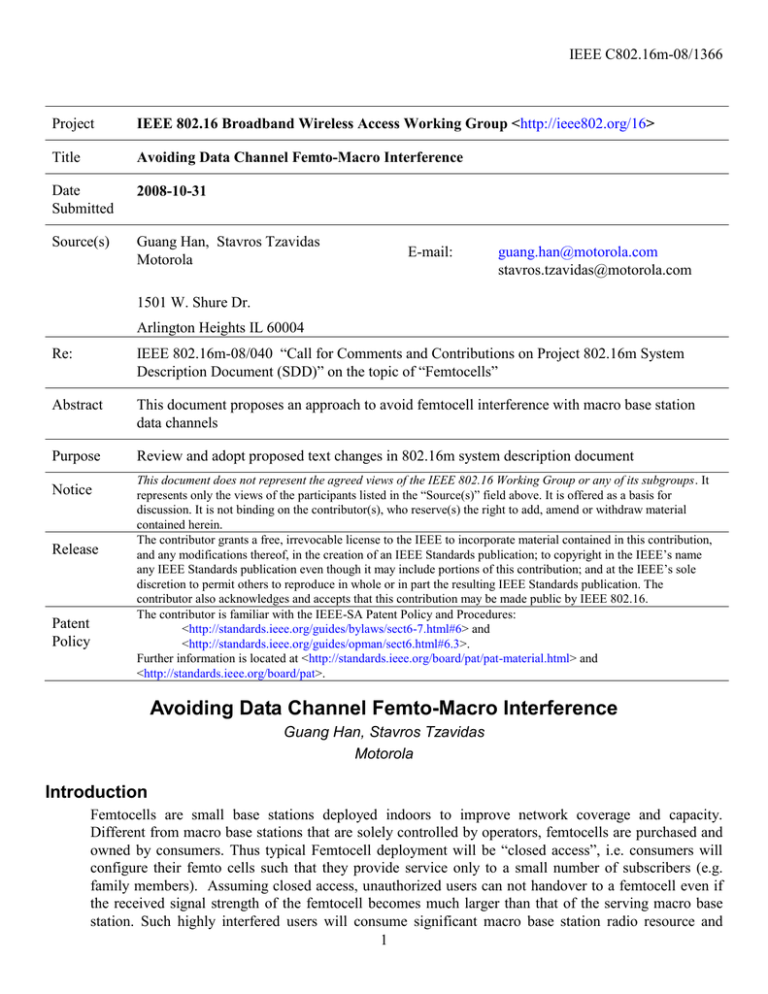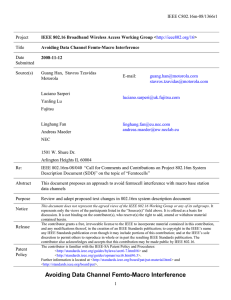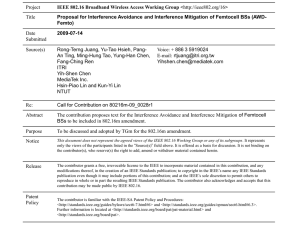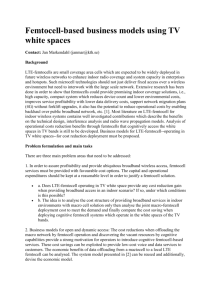IEEE C802.16m-08/1366 Project Title
advertisement

IEEE C802.16m-08/1366 Project IEEE 802.16 Broadband Wireless Access Working Group <http://ieee802.org/16> Title Avoiding Data Channel Femto-Macro Interference Date Submitted 2008-10-31 Source(s) Guang Han, Stavros Tzavidas Motorola E-mail: guang.han@motorola.com stavros.tzavidas@motorola.com 1501 W. Shure Dr. Arlington Heights IL 60004 Re: IEEE 802.16m-08/040 “Call for Comments and Contributions on Project 802.16m System Description Document (SDD)” on the topic of “Femtocells” Abstract This document proposes an approach to avoid femtocell interference with macro base station data channels Purpose Review and adopt proposed text changes in 802.16m system description document Notice Release Patent Policy This document does not represent the agreed views of the IEEE 802.16 Working Group or any of its subgroups. It represents only the views of the participants listed in the “Source(s)” field above. It is offered as a basis for discussion. It is not binding on the contributor(s), who reserve(s) the right to add, amend or withdraw material contained herein. The contributor grants a free, irrevocable license to the IEEE to incorporate material contained in this contribution, and any modifications thereof, in the creation of an IEEE Standards publication; to copyright in the IEEE’s name any IEEE Standards publication even though it may include portions of this contribution; and at the IEEE’s sole discretion to permit others to reproduce in whole or in part the resulting IEEE Standards publication. The contributor also acknowledges and accepts that this contribution may be made public by IEEE 802.16. The contributor is familiar with the IEEE-SA Patent Policy and Procedures: <http://standards.ieee.org/guides/bylaws/sect6-7.html#6> and <http://standards.ieee.org/guides/opman/sect6.html#6.3>. Further information is located at <http://standards.ieee.org/board/pat/pat-material.html> and <http://standards.ieee.org/board/pat>. Avoiding Data Channel Femto-Macro Interference Guang Han, Stavros Tzavidas Motorola Introduction Femtocells are small base stations deployed indoors to improve network coverage and capacity. Different from macro base stations that are solely controlled by operators, femtocells are purchased and owned by consumers. Thus typical Femtocell deployment will be “closed access”, i.e. consumers will configure their femto cells such that they provide service only to a small number of subscribers (e.g. family members). Assuming closed access, unauthorized users can not handover to a femtocell even if the received signal strength of the femtocell becomes much larger than that of the serving macro base station. Such highly interfered users will consume significant macro base station radio resource and 1 IEEE C802.16m-08/1366 probably lose their connections eventually. The interference scenario is depicted in the figure below. Macro Cell (MC) Mobile Station (MS) Femto Cell (FC) MS attempts to communicate with MC, while not allowed to access FC (closed access FC) In this contribution, we propose an approach to avoid Femtocell interference with macro base station data channels. The approach to handle control channel interference is given in [1]. Proposed Approach Large interference from an inaccessible Femtocell shall trigger a nearby MS to send measurement report to its serving macro base station. The macro base station can inform the Femtocell to block some frequency partition if the received Femtocell signal strength is above a given threshold T1. The interfered MS shall periodically report the Femtocell signal strength until it drops below a given threshold T2, which triggers the macro base station to notify the Femtocell to unblock the frequency partition. The macro base station may communicate with the Femtocell over the air or through the backhaul. The proposed mechanism requires to dynamically change the configuration. Alternatively, a static scheme can be adopted such that femtocells are always blocked from some pre-determined frequency partition. This pre-determined frequency partition can be Femtocell specific such that each Femtocell broadcasts its blocked frequency partition, or it can be macro cell specific such that each macro base station broadcasts certain frequency partition that can not be used by Femtocells under its coverage. It may also be a system parameter which is provided to the MS during registration. Proposed Text Changes [add the following subsection in Section 17 “Support for Femtocell” on page 104 of 802.16m-08/003r4] 2 IEEE C802.16m-08/1366 17.x Interference mitigation 17.x.1 Interference mitigation for data channels Large interference from an inaccessible Femtocell shall trigger a nearby MS to send measurement report to its serving macro base station. The macro base station can inform the Femtocell to block some frequency partition if the received Femtocell signal strength is above a given threshold T1. The interfered MS shall periodically report the Femtocell signal strength until it drops below a given threshold T2, which triggers the macro base station to notify the Femtocell to unblock the frequency partition. The macro base station may communicate with the Femtocell over the air or through the backhaul. Alternatively, a static scheme can be adopted such that femtocells are always blocked from some pre-determined frequency partition. This pre-determined frequency partition can be Femtocell specific such that each Femtocell broadcasts its blocked frequency partition, or it can be macro cell specific such that each macro base station broadcasts certain frequency partition that can not be used by Femtocells under its coverage. It may also be a system parameter which is provided to the MS during registration. References [1] IEEE C802.16m-08/1367, “Avoiding Control Channel Femto-Macro Interference.” 3


